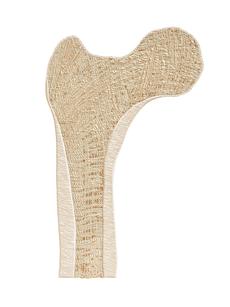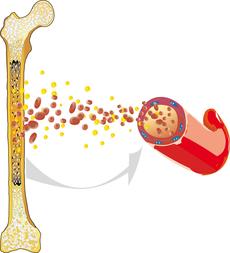Bone structure
Author: Dr. med. Gesche Riabowol (neé Tallen), Editor: Maria Yiallouros, Last modification: 2023/01/25 https://kinderkrebsinfo.de/doi/e121093
Table of contents
Bones mostly consist of mineralised bone tissue. To a lesser degree, they also contain soft tissue such as articular cartilage, the bone marrow inside the bone, an outer surface called periosteum, as well as nerves and blood vessels.
Bone tissue
Bone tissue comprises most of a bone. Its high density is a result of the high calcium content, which can reach about 70 % of a bone’s weight. There are two major types of bone tissue: compact bone tissue (Substantia compacta) and spongy bone tissue (Substantia spongiosa). Compact bone consists of highly dense, thus hard, white (osseous) tissue, which forms the tough outer shell of the long bones (such as the upper arm or leg bones). Instead, spongy bone is made of multiple tiny beams or rods called trabecula, which provide a rather soft and flexible consistency (like in flat bones such as vertebrae).
Bone tissue is composed by bone cells (osteocytes), which are connected to each other by small cellular processes. Osteoblasts and osteoclasts work together to maintain bone metabolism: osteoblasts create and mineralise bone tissue, thus being responsible for new bone (osteocyte) formation, whereas osteoclasts resorb bone tissue, thus breaking it down.
Articular cartilage
Articular cartilage is a rubber-like, smooth type of connective tissue that can be found at the ends of most bones, except, for example, the skull. By cushioning the joints, cartilage helps them to move well. Cartilage also represents a remainder of the embryonal, mainly cartilaginous skeleton.
Outer bone surface (periosteum)
The periosteum represents the outer surface of the bones in areas, where the bone tissue is not covered by cartilage. It is made of connective tissue which, apart from nerves and blood vessels, contains bone progenitor cells that can later develop into osteoblasts (see above). Thus, the periosteum supports bone nutrition and growth and participates in its recovery after an injury or fracture.
Bone marrow
Bone marrow is a soft tissue filling the cavities inside the bones. Two types of bone marrow exist: the red bone marrow, which produces the blood cells, and the yellow bone marrow, which is mainly comprised of fat cells. While all red at birth, the bone marrow converts into the yellow type with increasing age. In all adult long bones (such as the upper arm bones), the middle of shafts (diaphyses) are composed of yellow marrow, while red marrow can be found mainly in short and flat bones (such as the vertebrae).
Blood vessels and nerves
Bone tissue as well as periosteum and bone marrow contain blood vessels and nerves, which help with blood and oxygene supply as well as information exchange. Bones have tiny holes in their surface which allow the blood vessels and nerves to get in and out, thus to connect with blood circulation or the central nervous system, respectively.


